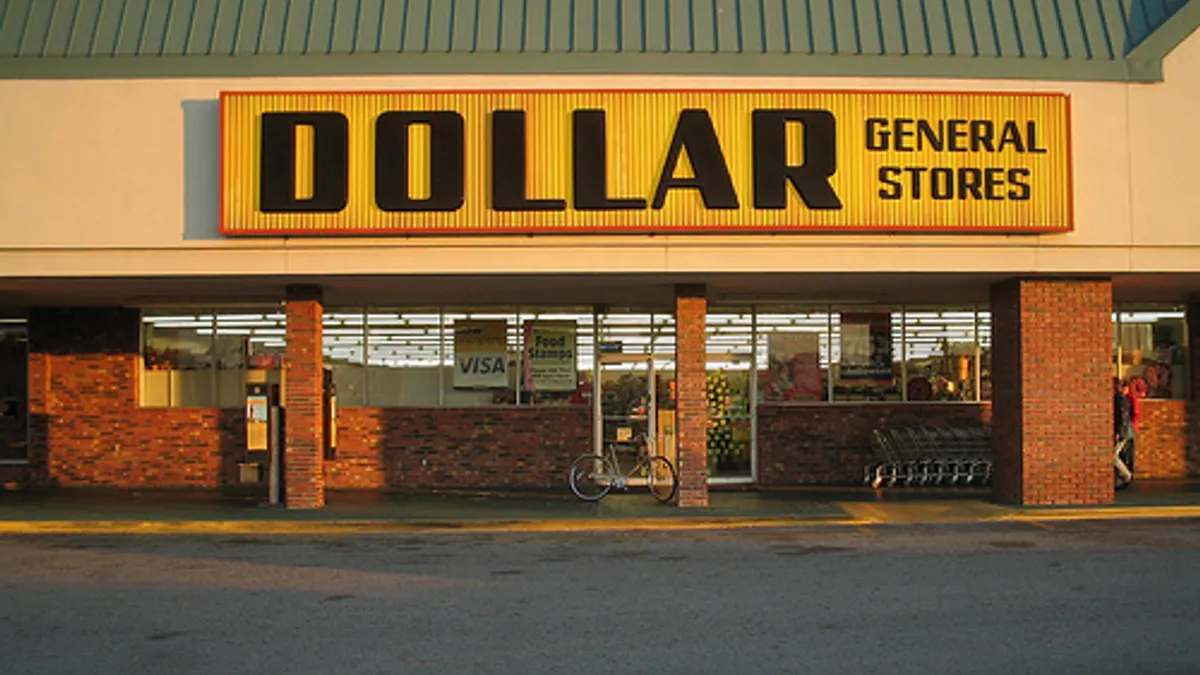Dive Brief:
-
Dollar General is taking bold steps to cut prices in order to drive sales and customer traffic, with an emphasis on its core lower-income customer segment, CEO Todd Vasos said on a conference call with analysts Thursday.
-
Dollar General stumbled in the second quarter, reporting same-store sales growth of just 0.7%, compared to analyst expectations from Consensus Metrix for a 2.6% increase. The discount retailer suffered from food price deflation, especially in items like milk (down 8%) and eggs (down more than 50%), its two largest perishable products, executives said.
-
State reductions in food stamp benefits and overall price competition in certain areas exacerbated Dollar General's sales woes, according to Vasos, who explained “price deflation and the reduction in [Supplemental Nutrition Assistance Program] benefits negatively impacted our same-store sales for the second quarter by approximately 60 to 70 basis points.”
Dive Insight:
Dollar stores have proven to be fairly robust in a tough retail era, but both Dollar General and Dollar Tree this week reported surprise weakness in sales and traffic. “[T]he 0.7% 2Q16 comp gain was [Dollar General's] weakest same store sales performance in over 10 years dating back to a Q4 2015, when it posted a 1.6% decline,” Retail Metrics analyst Ken Perkins wrote in a note to clients Thursday.
But CEO Vasos made it clear to investors that Dollar General understands its place in the retail landscape, one dependent on a low-income consumer without a lot of wiggle room in her household budget. In fact, though SNAP benefit reductions enacted in many states hurt the retailer, that is a signal that it’s a time when Dollar General’s customer “needs us most,” Vasos said.
“As for our core consumer, we operate with the reality that it is always challenging for her to stretch her budget given the pressures on her income and spending,” he said. “We have seen an ongoing contraction in core consumer all out with retail spending as reflected in the Nielsen Panel data.”
To offset the impact of price reductions, Vasos said the retailer will keep an eye on costs. And he asked for patience.
“We are taking aggressive action across merchandising and store operations to address these factors and help drive same-store sales,” he said. “And we will continue to be very disciplined in our [Selling, General and Administrative Expenses] spending… [I]t will take time to our initiatives to resonate with our consumer.”
But while pricing remains a common retailer strategy for driving traffic into stores, a recent RSR Research pricing report indicates merchants are not fulfilling other critical business objectives — like customer satisfaction and loyalty — that the intense price competition is meant to foster. Just 40% of retailers believe their pricing strategies build customer loyalty, down from 45% in 2015, RSR found. A mere 23% believe pricing is driving bottom line results, down from 32% last year, and only 35% percent of retailers believe they have a strategy in place to manage prices and promotions effectively across all channels.
“Consumers may be sensitive about price, but no retailer, not even the lowest-priced retailer, can win on price forever,” RSR partner and report author Paula Rosenblum said in a statement.














